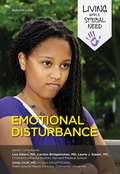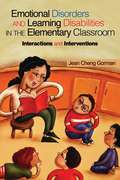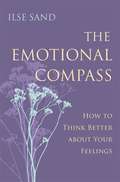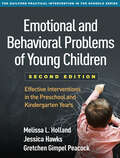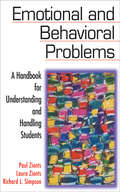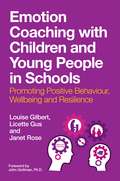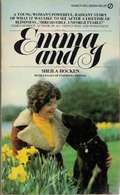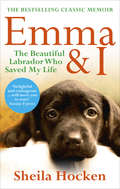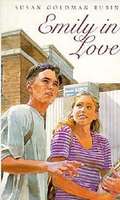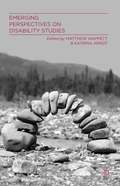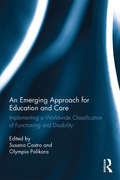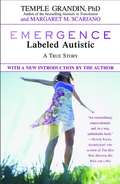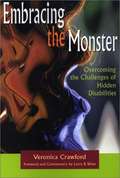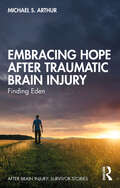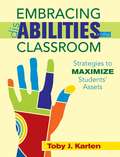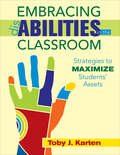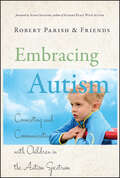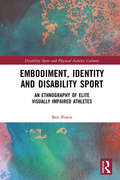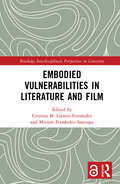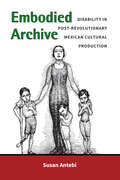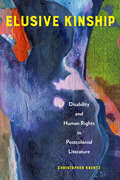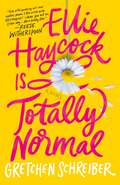- Table View
- List View
Emotional Disturbance
by Autumn LibalBeing a teenager is never easy. This phase of life is filled with changes, and new, unexpected challenges are always presenting themselves. For someone who has trouble controlling her emotions, these challenges can be especially hard to handle. As you read the story of Sheila, a teenager with an emotional disturbance, you will find out what it means to live with these extra challenges. You'll learn about some of the systems in place to help kids like Sheila, as well as some of the strengths and weaknesses of these systems. You'll discover that teenagers with emotional disturbance aren't so very different from you and your friends!
Emotional Disorders and Learning Disabilities in the Classroom: Interactions and Interventions
by Jean Cheng GormanThis unique book focuses on the interaction of learning disabilities and emotional disorders, fostering an understanding of how learning problems affect emotional well-being, and vice-versa. Jean Cheng Gorman provides research-based, classroom-tested practical interventions teachers can integrate into their daily routines, to help students become more purposeful and more effective. This book serves as a resource and a practical classroom guide for all elementary school teachers who are presented with the challenges of addressing the multiple needs - academic, emotional and social - of children with learning disabilities and emotional problems. Part I presents an overview of common learning disabilities and emotional problems. What disorders are teachers most likely to encounter? When should educators intervene, and when should they seek help from others? Part II offers specific classroom interactions and interventions, including insights on how: - Learning disorders are associated with emotional problems - Emotional problems can hide learning disabilities - Learning disorders can exacerbate emotional conditions - Emotional problems can intensify learning disabilities - Emotional health enhances learning . . . and each chapters includes tangible steps teachers can take in their classroom, as well as reproducibles that can be used as is, or as a starting point for materials development. The book ends with a rich and up-to-date list of additional resources for teachers and an annotated bibliography of children’s books and materials. Elementary teachers, administrators, and professional development directors can use this unique and comprehensive book as a solid foundation of knowledge and a practical resource for intervention.
The Emotional Compass: How to Think Better about Your Feelings
by Ilse Sand'Feelings are something we have, not something we are.' Revealing the complexity of emotions such as happiness, anger, fear, and jealousy, and how these are based on our perception of other people, Ilse Sand offers her professional wisdom on the psychology of feelings. Establishing that emotions are not always as appropriate as they first appear to be, the book encourages you to take a closer look at why you are feeling certain things, and how you can change how you feel. Especially written for highly sensitive people, guidance is included on how to identify the vulnerable feelings that often underlie our more volatile emotional states, and practical activities are suggested to help to embrace or reject sadness, delay impulsive actions, and allow yourself to be happy. Drawing on real-life examples throughout, the book offers you the means to improve your understanding of not only your own emotions and emotional actions, but those of others. The book will be immensely useful not only to people who feel things strongly, but to those who have trouble understanding or interpreting emotions and how to respond to the feelings they provoke.
Emotional and Behavioral Problems of Young Children, Second Edition: Effective Interventions in the Preschool and Kindergarten Years
by Gretchen Gimpel Peacock Jessica Malmberg Melissa L. HollandPresenting interventions that are practical, effective, and easy to implement in educational and clinical settings, this book addresses the most frequently encountered emotional and behavioral problems in 3- to 6-year-olds. Strategies for collaborating with parents are emphasized. Practitioners are taken step by step through assessing and treating conduct problems, anxiety and other internalizing problems, toileting difficulties, picky eating and related concerns, and sleep problems. User-friendly features include 36 reproducible parent handouts, assessment forms, and other clinical tools; the print book has a large-size format with lay-flat binding for easy photocopying. Purchasers get access to a Web page where they can download and print the reproducible materials. This book is in The Guilford Practical Intervention in the Schools Series. New to This Edition *Reflects over a decade of research advances, plus new assessments and interventions. *Updated for DSM-5. *Chapter on intervention within a multi-tiered system of support (MTSS). *Chapter on referral procedures for complex problems. *Mindfulness techniques for both parents and children. *Cutting-edge ways to use acceptance and commitment therapy principles and motivational interviewing with parents. *23 new or revised reproducible tools.
Emotional and Behavioral Problems: A Handbook for Understanding and Handling Students
by Richard L. Simpson Paul Zionts Laura T. ZiontsThe authors take a complex, under-discussed topic and give teachers and administrators useful, basic guidelines they can put to use quickly in understanding, identifying, and helping this special group of students.
Emotion Coaching with Children and Young People in Schools: Promoting Positive Behavior, Wellbeing and Resilience
by Louise Gilbert Licette Gus Janet RoseEmotion Coaching (EC) is a universal communication strategy which supports children and young people to self-regulate and manage their stress responses. Originally noticed as an effective way parents communicated with their children around challenging behaviours, Emotion Coaching has been shown to be highly successful in educational settings too. This is why the authors pioneered the research and application of Emotion Coaching into UK (primary and secondary) schools and community settings. The book includes straightforward descriptions and practical tips, with signposting to resources, case studies and vignettes to illustrate its practical application in educational settings. It supports adults to promote empathetic responses to challenging behaviours and situations, helping children and young people to understand their emotions and learn to manage them and their behavior in the longer-term.
Emma's Story
by Sheila HockenFrom the Book Jacket: SPRING DIGGING It was lovely helping Paddy in the garden. Digging up weeds -I gave her a helping paw there watching her put things in. After lunch Paddy said she'd put in everything she wanted to, and was now going to do some baking in the kitchen, but as it was quite sunny I could stop out in the garden. I went round again sniffing all the things she'd buried. Perhaps she'd left them there and wanted to get them out later, like I did sometimes with bones? If I did that for her now it would save her such a lot of time. So I went round and dug them all up. It took me ages. There were about a hundred. Won't she be pleased, I thought, when she knows I found every one and brought them all back for her? It wasn't long before she opened the door. 'Emma, come on in, it's teatime. ' Then she spotted the bulbs. I sat there looking pleased with myself. But she suddenly started laughing. 'Oh Emma... no. What have you done?' 'My name is Emma and I'm a chocolate-coloured labrador. Most other labradors are black or yellow, but not only am I a very special colour, I used to be a very special dog. I used to be a guide dog--and that isn't something any dog can do. So I'm going to tell you how to be a guide dog, right from the beginning, from when I was a puppy.' EMMA & I and EMMA V.I.P. have made Emma a very famous guide dog indeed. Now Sheila Hocken tells the full story of Emma's training from Emma's point of view This really is Emma's story, a book as lovable and lively as Emma herself.
Emma V.I.P
by Sheila HockenSequel to Emma and I. Sheila talks about her life after being able to see again, about learning and relearning to read print, about seeing snow for the first time, and about the other things, including the pitfalls and joys of regaining vision. She also talks about the birth of her daughter Kerensa, and of three additions to the family, of her dreams of owning a cattery and kennels, and of Don's and her fears that Kerensa may be blind. The story is interwoven with stories of Emma, in retirement, of the publication of Emma and I, and of the new pups in the family, Bracken and Buttons.
Emma and I
by Sheila HockenA touching and unique story of love and courage. This is Sheila Hocken's own story. A story of a young blind girl who sets out to fight for the right to live fully and to see again. Sheila's account of the events and people that transformed her life is moving and inspiring. Sheila introduces Emma, her beautiful chocolate-brown labrador, whose devotion and intelligence as a guide dog are inspiring. We also meet Don, who brings romance into Sheila's life - through a radio program! And we meet Mr Shearing, the skilled surgeon who performs the miracle which gives Sheila a whole new world.
Emma and I
by Sheila HockenAs a girl, Sheila never let her gradual descent into blindness prevent her from trying to do everything a sighted person could do. Then at 17, unable to see to find her way around the house she grew up in, she found herself dreading her future in an 'ever darkening vacuum'.But then the remarkable Emma enters her life, and Sheila begins a journey that brings her the independence, love and happiness she never dreamed possible.Emma and I is the moving and inspirational story of the unique bond between Sheila and her dog, and shows that, sometimes, miracles do happen.
Emma and Co.
by Sheila HockenIn Emma and Co readers will be delighted to renew their acquaintance with Sheila Hocken, her family and, of course, her dogs. Since the miraculous operation which restored her sight Sheila in gratitude to Emma, her devoted guide-dog, companion and best friend, has grown into a love of all dogs--and in particular chocolate-coloured Labradors. Perhaps it is because in watching them grow up she can see for the first time how Emma herself must have looked as a young dog, dancing with excitement at the prospect of going out wearing her distinctive guide-dog harness. Now, as Emma enjoys her well- earned retirement, the other dogs take up more and more time for Sheila, her husband Don and their daughter Kerensa. There is Bracken, full of fun and mischief; Buttons, whose first litter of puppies gives problems but also great pride: one of them is accepted by the Guide-Dog Association to be trained as a guide-dog. There is Mocha, beautiful but absentminded; Teak, whom she buys for Don's birthday to make a change from aftershave and socks; and Shadow, with whom she develops a great interest in Obedience Trials. All of them appear here and will certainly endear themselves to the reader as they have already done to the Hocken family. Emma and Co is full of delightful (and sometimes disastrous) anecdotes, both human and animal. But there is great sorrow in it too, for in the end Sheila must learn to live without the dog who was her 'eyes' for many years.
Emily in Love
by Susan Goldman-RubinWhen Emily Gold sees Hunt in the school yard her first day of "regular" school, she hopes he'll be her boyfriend. Pretty Emily, who is developmentally disabled, wants more than anything else to fit in. Will Hunt like her even though she's not like the other kids?
Emerging Perspectives On Disability Studies
by Matthew Wappett Katrina ArndtEmerging Perspectives on Disability Studies brings together up-and-coming scholars whose works expand disability studies into new interdisciplinary contexts. This includes new perspectives on disability identity; historical constructions of (dis)ability; the geography of disability; the spiritual nature of disability; governmentality and disability rights; neurodiversity and challenges to medicalized constructions of autism; and questions of citizenship and participation in political and sexual economies. In sum, this volume uses disability studies as an innovative framework for its investigation into what it means to be human.
An Emerging Approach for Education and Care: Implementing a Worldwide Classification of Functioning and Disability
by Susana Castro Olympia PalikaraAn Emerging Approach for Education and Care provides a synthesis of the extensive research that has been conducted worldwide about the International Classification of Functioning, Disability and Health for Children and Youth in education and care. The main purpose of the ICF is to provide a classification of functioning for adults and children with difficulties, considering their everyday lives, all the activities they perform and the environments they are embedded in, in addition to their health condition, which has been the traditional focus of Special Education provision in many countries. Each chapter presents an evidence-based study describing how the ICF has been used to improve the provision of services for children and young people with Special Educational Needs around the world. Moreover, each chapter is written by an expert on the ICF from a different country, thus providing an overview of how the ICF can be applied in international educational contexts with different educational and health systems and cultural backgrounds. This synthesis of world-leading research focuses on the ICF as a framework to approach assessment, intervention and classification for children and young people with SEN, whilst also providing practical examples of how it can be implemented. An Emerging Approach for Education and Care will be essential reading for academics, researchers and practitioners working on Special Educational Needs provision and rehabilitation. It should also be of great interest to those involved in the study of early childhood education, and for postgraduate students aspiring to work in these settings.
Emergence: Labeled Autistic
by Temple Grandin Margaret M. ScarianoA true story that is both uniquely moving and exceptionally inspiring, Emergence is the first-hand account of a courageous autistic woman who beat the odds and cured herself. As a child, Temple Grandin was forced to leave her "normal" school and enroll in a school for autistic children. This searingly honest account captures the isolation and fears suffered by autistics and their families and the quiet strength of one woman who insisted on a miracle.
Embracing the Monster: Overcoming the Challenges of Hidden Disabilities
by Veronica CrawfordWhat is it like to live with disabilities no one can see? Readers will find out in this honest and gripping narrative of one woman's life with hidden disabilities--including learning disabilities, ADHD, and bipolar disorder. Yet this is more than just her story of battling adversity and coming out a winner.
Embracing Hope After Traumatic Brain Injury: Finding Eden (After Brain Injury: Survivor Stories)
by Michael S. ArthurThis important book provides a firsthand account of a university professor who experienced traumatic brain injury. It tells the story of Michael Arthur, who had recently accepted a position as vice principal of a new high school. After only two weeks on the job, he was involved in a car accident while driving through an intersection in northern Utah. Through his personal account, he takes the reader into the dark interworkings of his mind as he tries to cope with his new reality. He provides insight into how he learned how to process information and even speak without stumbling on his words while also sharing how his significant relationships suffered as he tried to navigate the restless seas of doubt while trying to circumvent his unyielding symptoms. The book is about finding optimism and gaining insight into the struggles of the brain-injured patient and about trying to understand the perspectives of loved ones who can’t quite grasp the idea of an invisible injury. From the sudden onset of garbled speech to the challenges of processing information, the changing dynamic of the author’s life is highlighted to help family members and healthcare workers better understand.
Embracing Disabilities in the Classroom: Strategies to Maximize Students? Assets
by Toby KartenHow we treat others often influences how individuals feel about themselves. This book illustrates how educators can effectively promote sensitive, inclusive classroom practices that maximize success for students with disabilities. Embracing Disabilities in the Classroom provides content-rich interdisciplinary lessons accompanied by behavioral, academic, and social interventions that capitalize on student strengths. Inclusion expert Toby J. Karten demonstrates the impact of literature, self-advocacy, role playing, and strategic interventions on students' growth and achievement. The numerous lessons, tables, rubrics, instructional guidelines, and charts help readers: * Determine effective strategies for differentiating instruction for specific disabilities * Modify lessons and curriculum appropriately in the content areas * Encourage students to become active participants in learning * Increase disability awareness and foster inclusive mind-sets in students, colleagues, and families This practical resource provides special education and general education teachers, principals, and teacher leaders with both effective instructional strategies for curriculum delivery and responsive approaches to promoting positive attitudes toward disabilities. Given appropriate support and an accepting environment, all students are able to achieve, thrive, and succeed in school and in life!
Embracing Disabilities in the Classroom: Strategies to Maximize Students’ Assets
by Toby J. KartenFoster positive experiences by differentiating not only instruction but attitudes too! This practical resource illustrates how educators can effectively promote sensitive, inclusive practices that maximize success for students with disabilities. Karten demonstrates the impact of literature, self-advocacy, role playing, and behavioral, academic, and social interventions on students’ growth. The numerous tables, rubrics, instructional guidelines, charts, and content-rich interdisciplinary lessons help readers: - Determine effective strategies for differentiating instruction for specific disabilities - Modify lessons and curriculum appropriately in the content areas - Encourage students to become active participants in learning - Increase disability awareness and foster inclusive mind-sets in students, colleagues, and families
Embracing Autism
by Susan Senator Robert Parish"The voices here confirm what I've always suspected: everyone is part of one large continuum, and the approaches and insights recounted here can help any parent, any educator, any person deal with any child--or, for that matter, any other person--more effectively and with more compassion. I only wish I'd encountered earlier this cadre of experienced and caring individuals whose humor and resourcefulness represent clearly how best to love and nurture a child."--Cynthia Nitz Ris, J.D., Ph.D., University of CincinnatiThrough sensitive, sometimes humorous, experienced-based writing from teachers, clinicians, and parent activists in the Autism Spectrum Disorder (ASD) community, this book will help educators and others to better understand the world inhabited by ASD children. The stories contained in the book will inspire and inform readers who are working day-to-day with children in the autism spectrum, providing valuable insights into what makes these kids tick and useful information on how they communicate, learn, and succeed.Robert Parish (Cincinnati, OH) is an award-winning journalist with four nationally broadcast public TV documentaries about Autism Spectrum Disorders to his credit, as well as more than 100 digital video projects about ASD for the educational market.
Embodiment, Identity and Disability Sport: An Ethnography of Elite Visually Impaired Athletes (Disability Sport and Physical Activity Cultures)
by Ben PowisThis book investigates the complex relationship between embodiment, identity and disability sport, based on ethnographic research with an international-level visually impaired cricket team. Alongside issues of empowerment, classification and valorisation, it conceptualises the sensuous dimension of being in disability sport and challenges the idealised notion of the sporting body. It explores the players’ lived experiences of participating and competing in an elite disabled sport culture and uses an embodied theoretical approach drawing upon sociology, phenomenology and contemporary disability theory to examine aspects of this previously unexamined research "site," both on and off the pitch. Written in a way that values and accurately represents the participants’ traditionally marginalised voices, the book analyses the role that elite disability sport plays in the construction of identity and helps us to better understand the relationships between disability, sport and wider society. Embodiment, Identity and Disability Sport is essential reading for any student, researcher, practitioner or policymaker working in disability sport, and a source of useful new perspectives for anybody with an interest in the sociology of sport or disability studies.
Embodied VulnerAbilities in Literature and Film (Routledge Interdisciplinary Perspectives on Literature)
by Gámez-Fernández, Cristina M Miriam Fernández-SantiagoEmbodied VulnerAbilities in Literature and Film includes a collection of essays exploring the ways in which recent literary and filmic representations of vulnerability depict embodied forms of vulnerability across languages, media, genres, countries, and traditions in the late 20th and early 21st centuries. The volume gathers 12 chapters penned by scholars from Japan, the USA, Canada, and Spain which look into the representation of vulnerability in human bodies and subjectivities. Not only is the array of genres covered in this volume significant— from narrative, drama, poetry, (auto)documentary, or film— in fiction and nonfiction, but also the varied cultural and linguistic coordinates of the literary and filmic texts scrutinized—from the USA, Canada, Spain, France, the Middle East, to Japan. Readers who decide to open the cover of this volume will benefit from becoming familiar with a relatively old topic— that of vulnerability— from a new perspective, so that they can consider the great potential of this critical concept anew.
Embodied Archive: Disability in Post-Revolutionary Mexican Cultural Production (Corporealities: Discourses Of Disability)
by Susan AntebiEmbodied Archive focuses on perceptions of disability and racial difference in Mexico’s early post-revolutionary period, from the 1920s to the 1940s. In this period, Mexican state-sponsored institutions charged with the education and health of the population sought to strengthen and improve the future of the nation, and to forge a more racially homogeneous sense of collective identity and history. Influenced by regional and global movements in eugenics and hygiene, Mexican educators, writers, physicians, and statesmen argued for the widespread physical and cognitive testing and categorization of schoolchildren, so as to produce an accurate and complete picture of “the Mexican child,” and to carefully monitor and control forms of unwanted difference, including disability and racialized characteristics. Differences were not generally marked for eradication—as would be the case in eugenics movements in the US, Canada, and parts of Europe—but instead represented possible influences from a historically distant or immediate reproductive past, or served as warnings of potential danger haunting individual or collective futures. Weaving between the historical context of Mexico’s post-revolutionary period and our present-day world, Embodied Archive approaches literary and archival documents that include anti-alcohol and hygiene campaigns; projects in school architecture and psychopedagogy; biotypological studies of urban schoolchildren and indigenous populations; and literary approaches to futuristic utopias or violent pasts. It focuses in particular on the way disability is represented indirectly through factors that may have caused it in the past or may cause it in the future, or through perceptions and measurements that cannot fully capture it. In engaging with these narratives, the book proposes an archival encounter, a witnessing of past injustices and their implications for the disability of our present and future.
Elusive Kinship: Disability and Human Rights in Postcolonial Literature
by Christopher KrentzCharacters with disabilities are often overlooked in fiction, but many occupy central places in literature by celebrated authors like Chinua Achebe, Salman Rushdie, J. M. Coetzee, Anita Desai, Jhumpa Lahiri, Edwidge Danticat, and others. These authors deploy disability to do important cultural work, writes Christopher Krentz in his innovative study, Elusive Kinship. Such representations not only relate to the millions of disabled people in the global South, but also make more vivid such issues as the effects of colonialism, global capitalism, racism and sexism, war, and environmental disaster. Krentz is the first to put the fields of postcolonial studies, studies of human rights and literature, and literary disability in conversation with each other in a book-length study. He enhances our appreciation of key texts of Anglophone postcolonial literature of the global South, including Things Fall Apart and Midnight’s Children. In addition, he uncovers the myriad ways fiction gains energy, vitality, and metaphoric force from characters with extraordinary bodies or minds. Depicting injustices faced by characters with disabilities is vital to raising awareness and achieving human rights. Elusive Kinship nudges us toward a fuller understanding of disability worldwide.
Ellie Haycock Is Totally Normal
by Gretchen SchreiberThe Breakfast Club meets Five Feet Apart in this big-hearted novel from debut author Gretchen Schreiber.Ellie Haycock has always separated her life into sections: Ellie at home and Ellie at the hospital. At home, Ellie is a proud member of her high school’s speech and debate team alongside her best friend and her boyfriend. At the hospital, Ellie has a team of doctors and a mom who won’t stop posting about the details of her illness online. It’s not hard for Ellie to choose which of the two she prefers.But this latest hospital stay is different. Ellie becomes close with a group of friends, including Ryan, a first-timer who’s still optimistic about the doctors that Ellie stopped trusting years ago. Despite their differences, she can’t seem to keep him out of her head. Ellie’s life has never been ordinary—but maybe this time it will be extraordinary.
